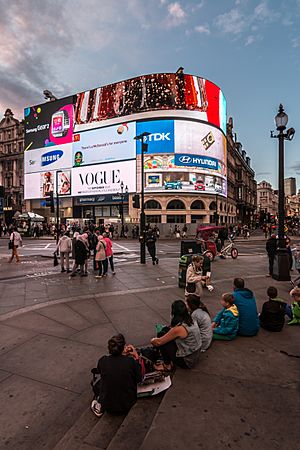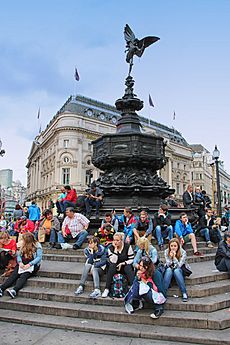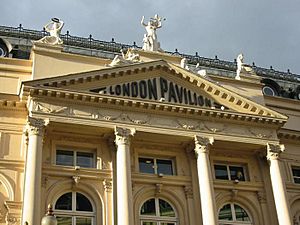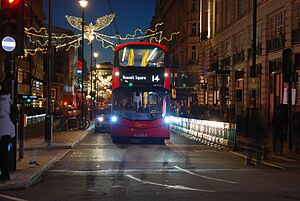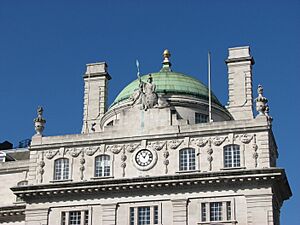Piccadilly Circus facts for kids
Quick facts for kids Piccadilly Circus |
|
|---|---|

Piccadilly Circus in 2012
|
|
| Location | |
| London, United Kingdom | |
| Coordinates: | 51°30′36″N 0°8′4″W / 51.51000°N 0.13444°W |
| Roads at junction: |
Regent Street, Piccadilly, Shaftesbury Avenue, The Haymarket, Coventry Street and Glasshouse Street |
| Construction | |
| Type: | Road junction |
| Opened: | 1819 |
| Map | |
| Lua error in Module:Infobox_road/map at line 15: attempt to index field 'wikibase' (a nil value). | |
Piccadilly Circus is a famous road junction and public space in the West End of London, England. It's in the City of Westminster. It was built in 1819 to connect Regent Street with Piccadilly. In this case, the word "circus" comes from a Latin word meaning "circle." It describes a round open space where several streets meet.
Today, Piccadilly Circus connects Piccadilly, Regent Street, Shaftesbury Avenue, the Haymarket, Coventry Street (which leads to Leicester Square), and Glasshouse Street. It is very close to London's main shopping and entertainment areas. Because it's a major meeting point for roads, Piccadilly Circus is a busy place and a popular spot for tourists. It is especially known for its huge video screens and bright neon signs. These signs are on the corner building on the north side. You can also see the Shaftesbury Memorial Fountain there. It has a statue that many people mistakenly call Eros.
Many important buildings surround the Circus. These include the London Pavilion and the Criterion Theatre. Below the ground is Piccadilly Circus Underground station. This is part of London's subway system.
Contents
History of Piccadilly Circus
Piccadilly Circus connects to Piccadilly, a street named after a type of collar called "piccadills." A tailor named Robert Baker, who sold these collars, owned a house called Piccadilly Hall in 1626. The street was later known as Portugal Street for a while. This was to honor Catherine of Braganza, who was the queen of King Charles II of England. But by 1743, it was known as Piccadilly again.
How Piccadilly Circus Was Created
Piccadilly Circus was created in 1819. It was built where Regent Street met Piccadilly. John Nash planned the construction of Regent Street. The Circus lost its perfect circular shape in 1886 when Shaftesbury Avenue was built.
This junction has always been a very busy place for traffic. It is in the middle of London's Theatreland, where many theaters are located. It also handles traffic leaving Piccadilly. A writer named Charles Dickens, Jr. described Piccadilly in 1879 as London's closest thing to a Parisian boulevard.
Underground Station and Early Advertisements
The Piccadilly Circus tube station opened on March 10, 1906, for the Bakerloo line. The Piccadilly line followed in December of that year. In 1928, the station was rebuilt to handle more people. The first electric advertisements appeared at the junction in 1910. By 1923, electric billboards were put up on the London Pavilion building. Traffic lights were first installed here on August 3, 1926.
Changes and Redevelopment Plans
In the early 1960s, people thought Piccadilly Circus needed to be changed. This was to allow more traffic to flow through. In 1962, Lord Holford suggested a "double-decker" Piccadilly Circus. This plan would have created an upper level for people to walk on. The lower level would have been only for cars. However, these plans were eventually rejected. The main reason was that Holford's plan would only increase traffic flow by 20%. The government wanted a 50% increase.
Piccadilly Circus has not had any major redevelopment since then. But in the 1980s, more areas were made for people to walk on the south side.
Shaftesbury Memorial Fountain
The Shaftesbury Memorial Fountain stands at the southeastern side of the Circus. It was put up in 1893 to remember the good deeds of Anthony Ashley Cooper, 7th Earl of Shaftesbury. He was a Victorian politician and a philanthropist (someone who helps others). During the Second World War, the statue on top of the fountain was removed for safety. It was replaced by advertising signs. The statue was returned in 1948. When the Circus was rebuilt in the late 1980s, the whole fountain was moved. It went from the center of the junction to its current spot at the southwestern corner.
What to See at Piccadilly Circus
Piccadilly Circus is surrounded by many popular places for tourists. These include the Shaftesbury Memorial, the Criterion Theatre, the London Pavilion, and many shops. Nightclubs, restaurants, and bars are also in the area and in nearby Soho.
Famous Illuminated Signs
Piccadilly Circus has been famous for its bright advertising signs since 1908. Back then, a Perrier sign was the first. Now, only one building on the northwestern corner has these huge signs. This building is often called "Monico."
The first signs used regular light bulbs. Later, they were replaced with neon lights and even moving signs. The first neon sign was for a British meat extract called Bovril. From 1998, digital projectors were used for the Coke sign. Then, in the 2000s, the signs slowly changed to LED displays. By 2011, all neon lamps were replaced by LEDs.
The number of signs has gone down over the years because renting the space has become very expensive. In January 2017, the six remaining advertising screens were turned off. This was part of a plan to combine them into one giant, curved LED screen. This was the longest time the signs had been off since the 1940s. The new screen was switched on for the first time on October 26, 2017.
Here are some of the companies that have had signs there:
- Coca-Cola has had a sign at Piccadilly Circus since 1954.
- Hyundai Motors launched its sign in 2011. It replaced a sign for Sanyo.
- McDonald's added its sign in 1987.
- Samsung added its sign in 1994.
- Other companies like L'Oreal, Hunter Original, and eBay have also had signs since 2017.
Sometimes, the lights are turned off for special events. For example, they were turned off when Winston Churchill died in 1965 and when Diana, Princess of Wales died in 1997. On June 21, 2007, they were off for an hour as part of a campaign called Lights Out London. After the death of Queen Elizabeth II, all advertising was replaced with an image honoring her.
Shaftesbury Memorial and the Statue of Anteros
On the southeastern side of the Circus is the Shaftesbury Memorial Fountain. It was put up in 1892–1893. It remembers the good work of Lord Shaftesbury. He was a Victorian politician and social reformer. The statue on the Memorial is of the Greek god Anteros. It was named The Angel of Christian Charity. However, most people mistakenly call it Eros.
Criterion Theatre
The Criterion Theatre is a historic building on the south side of Piccadilly Circus. It is a Grade II* listed building, which means it's very important. Except for the ticket office, the entire theater is underground. It has almost 600 seats. You go down a tiled staircase to get inside.
The theater was designed by Thomas Verity. It opened on March 21, 1874. It closed in 1883 to improve the air flow and change from gaslights to electric lights. It reopened the next year. The theater closed again in 1989 for a big renovation and reopened in October 1992.
London Pavilion
On the northeastern side of Piccadilly Circus is the London Pavilion. The first building with this name was built in 1859 and was a music hall. In 1885, a new London Pavilion was built. It also served as a music hall. In 1924, electric billboards were put on the side of the building.
In 1934, the building was changed a lot and became a cinema. In 1986, it was rebuilt again. The old 1885 front of the building was kept. It was turned into a shopping arcade. In 2000, the building was connected to the Trocadero Centre next door. The signs on the building were changed in 2003 to say "London Trocadero." The basement of the building connects to the Underground station.
Major Shops Around the Circus
The former Swan & Edgar department store is on the west side of the Circus. It was built in 1928–29. After it closed in the 1980s, the building became home to music stores like Tower Records and Virgin Megastore. Now, a clothing brand called The Sting is there.
Lillywhites is a big shop that sells sporting goods. It is on the corner of the Circus and Lower Regent Street, next to the Shaftesbury fountain. It moved to this spot in 1925. Lillywhites is popular with tourists. They often have sales, including on international football jerseys. Nearby, Fortnum & Mason is a famous store known for its large food hall.
County Fire Office Building
On the north side of the Circus, at the corner of Glasshouse Street, is the County Fire Office building. It has a statue of Britannia on its roof. The original building was designed by John Nash. In 1924, the old building was taken down and replaced with a similar one. This new building was designed by Reginald Blomfield, but it kept the statue of Britannia. During the London Blitz in World War II, it was the only building in the Circus that was damaged. It is now a Grade II listed building.
Piccadilly Circus Underground Station
The Piccadilly Circus station is part of the London Underground system. It is located directly under Piccadilly Circus itself. You can find entrances at every corner of the Circus. It is one of the few stations that does not have any buildings above ground. The station's underground concourse and subway entrances are also Grade II listed.
The station is on the Piccadilly line, between Green Park and Leicester Square. It is also on the Bakerloo line, between Charing Cross and Oxford Circus.
Piccadilly Circus in Popular Culture
The phrase it's like Piccadilly Circus is often used in the UK. It means a place or situation is extremely busy with many people. Some people say that if you stay long enough at Piccadilly Circus, you will eventually meet everyone you know! Because of this, during World War II, "Piccadilly Circus" was the secret code name for where the Allies' D-Day invasion ships gathered in the English Channel.
Piccadilly Circus has also inspired artists and musicians. Piccadilly Circus (1912) is the name of a painting by British artist Charles Ginner. It is part of the Tate Britain collection. The artist Paul McCarthy also has a book of video stills called Piccadilly Circus. Bob Marley mentioned Piccadilly Circus in his song "Kinky Reggae" from his 1973 album Catch a Fire.
A painting by L. S. Lowry R.A. called 'Piccadilly Circus, London' (1960) was sold for over £5.6 million in 2011.
Images for kids
-
Piccadilly Circus in 1896, looking towards Leicester Square via Coventry Street. London Pavilion is on the left, and Criterion Theatre on the right.
See also
 In Spanish: Piccadilly Circus para niños
In Spanish: Piccadilly Circus para niños



